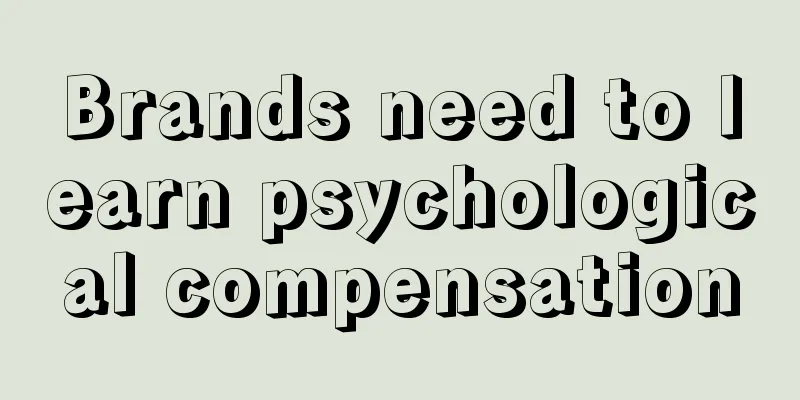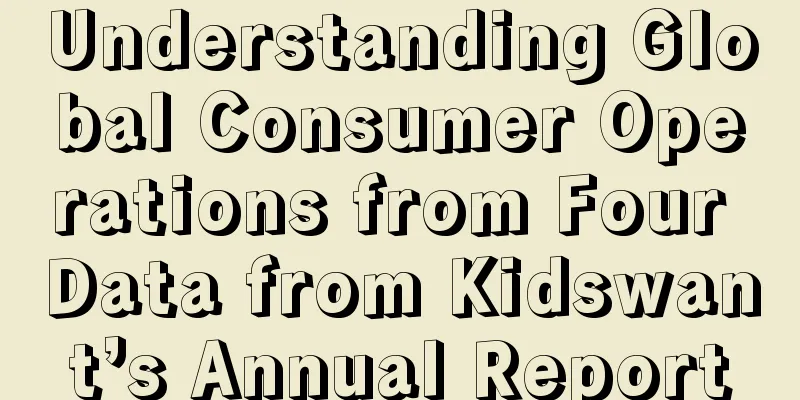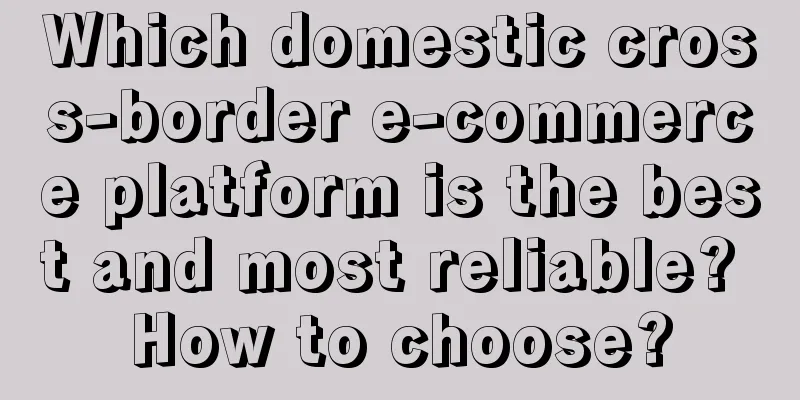Brands need to learn psychological compensation

There was a time when I particularly liked to drink sparkling water. The feeling of burping was wonderful. Later, I switched to black tea, and now I prefer Oriental Leaves. You may say that I am fickle and get tired of the old and love the new. Yes, you can't expect a person to always like only one brand. I have talked to many businesses recently. When their sales decline, they always blame the problem on price, believing that the products are more expensive and sales will be poor. Is it really a price issue? Not really. Some people mistakenly believe that as long as the product is high quality and cheap, they will be successful. On Taobao, some products of the same type have high sales, while others are almost ignored. In WeChat Moments, there are many articles with the same viewpoint, but only a few of them have more than 100,000 views. How to explain this? You may think that understanding consumer behavior is not that important, and you should put your energy into improving products and reducing costs. After all, everyone says that good wine does not need to be hidden in a remote alley. Now is the fifth consumer era, a period of low desire. In fact, while improving products and reducing costs are important, simply offering good quality and low prices will not attract consumers. Maybe the problem has nothing to do with price. If you can understand what consumers want, they may find your product unforgettable. Understanding and applying “compensatory psychology” is a key marketing strategy in this process. 01What does compensation psychology mean? Let me give you an example: Suppose a boy encounters troubles and is under great pressure at work, but he cannot find a solution; at this time, he will seek the company and comfort of his girlfriend; through mutual communication in the relationship, he can make up for the shortcomings in his work, which is compensation. Similarly, if a girl feels ignored or misunderstood in her social circle, she will seek more attention and understanding from her boyfriend, which is also a compensatory behavior. Therefore, compensatory psychology, also called psychological compensatory effect, means that when an individual encounters setbacks in certain aspects and cannot realize his wishes, he will turn to seek satisfaction in other aspects to make up for the original shortcomings. To put it in marketing terms, many times, we buy things not because we really need them, but because we want to make up for perceived deficiencies and maintain our inner balance. for example: When you are stressed out at work, you might relax by eating or drinking. When a friend questions your taste in clothing, you might find someone who dresses similarly to you to support your point of view. Store guides often take advantage of this mentality. They will emphasize the social status of the product, so that consumers feel that the price they pay is worth it and guide them to buy the product. According to observation, people need five kinds of compensation in their daily life: material, physical, time, social and knowledge. What? No way, there are so many, where are they manifested? Let’s talk about material compensation first. Most young people are interested in electronic products, such as iPhone, but due to the high prices, many people may not be able to afford them. What should they do? At this time, people will choose to buy an older model, or a product that looks similar to the iPhone, such as Xiaomi. At this point, users may think that although they can’t afford the new model now, they can always buy an old model or a similar product to show off on social media. At that moment, users will have a feeling of transcending the consumption class and improving their self-image; they can label themselves as high-tech and fashionable by spending a relatively small price. However, material compensation has a lot to do with achievement. When you complete a big project, you may choose to buy something to celebrate this achievement. This pleasure of buying things is like a reward and appreciation for yourself, which makes people feel satisfied and proud; conversely, when you are full of regrets, your compensatory consumption is also a compensation. for example: You have been working for a week and are very tired. You feel the need to treat yourself, so you decide to buy an expensive piece of clothing that you have been looking at for a long time but have been hesitant about. You may tell yourself: I have worked hard all week, I deserve it. Think about it, have you ever had a similar experience? The main characteristic of material things is buying, buying, buying. Let’s talk about body compensation. What? Body, you want me to sell myself? No, this is another kind of money (joking); Simply put, when people face psychological pressure, they will relieve it through intense physical activities such as sports, dancing, handicrafts, etc. for example: A person who is experiencing a high-pressure work environment may choose to participate in a marathon, and a person who is in emotional distress may choose to exercise to gain a sense of satisfaction and relieve stress. What is time compensation? People choose to divert their time and energy to other things to relieve the current distress or stress; this is usually a positive coping strategy that can help you to get out of the difficult situation and focus on more constructive or beneficial things. When I feel tired from content creation, I like to take a hike and take a walk downstairs to offset the stress and fatigue from the workday. Social compensation is relatively easy to understand. It includes having dinner partners and dating strangers. When a person is frustrated in a relationship, he will seek support and understanding from friends or other social circles to offset the pressure and frustration. I don’t know if you have noticed that when you watch short videos and see some emotional sentences, you will be touched for no reason, and then click in to see that the blogger is recommending a certain book. This is knowledge compensation. Oriental Leaves’ knowledge compensation has been popular on the Internet recently. for example: It's a pity that you don't drink Oriental Leaves, so you can't experience the dull and tasteless astringency, just like life is bitter at first, but slightly sweet after careful sip; it's a pity that you don't drink Oriental Leaves, so you don't understand my deep affection. Oh, I'm fine in other aspects, but how could you poke my heart? Therefore, users will generally choose brands that are consistent with their values at some point. This is a kind of deep identification, just like I sometimes post jokes on WeChat Moments to refute those difficult times. 02You may wonder, what does this have to do with the brand? You know, the way of advertising has changed. In the past, advertising was like sowing seeds, spreading from one place to everywhere. We always want to attract as much consumer attention as possible, just like competing for a precious resource. Marketing thinking tries every means to grab users, make them listen to us, and keep them in circulation as much as possible. Now all major platforms have incubated various KOLs. On the Douyin platform alone, there are more than 4,000 big Vs with more than 10 million fans, more than 60,000 internet celebrities with 100,000 to 1 million fans, not to mention KOCs, there are a lot of them. Therefore, in the digital age, everyone can promote their products on social media, and the secret to brand success has changed. Only by finding the information dissemination point, linking users into a small organization, injecting unique culture into the small organization, and then letting the culture penetrate into the hearts of more people can success be achieved. This also explains why brands like Heytea, Xiaomi, Pinduoduo, and Mixue Bingcheng are successful, because they focus on word-of-mouth marketing and word of mouth. So, what role does brand play in communication? First, node A brand is an independent source of information dissemination, which may be the motivation for an activity, a social event, or event marketing. You are a handmade chocolate brand. You decide to launch a limited edition rose chocolate during Valentine’s Day. In this case, the release of “new product information” and your social media promotion activities can be considered a “node”. If you invite an influential food blogger to try and review the new chocolate, that blogger becomes another “node” when she shares her experience on her blog or on social media. This node has its own audience or fan group, so her recommendation can further spread your brand information. Second, the connector (Linker) What is a connection? It can pass information from one node to another, or even connect various nodes together. It may be a brand partner, or a KOL (key opinion leader), KOC (key opinion consumer), or an Internet celebrity, etc. For example: Nike (node 1) launches a new sports shoe and decides to work with the famous basketball player LeBron James (connector) to promote the new shoe. LeBron James posts a photo of himself wearing the new shoe on social media and tags Nike; his fans (node 2) see the message and some of them decide to buy the new shoe. At the same time, some of these fans are also posting photos of themselves wearing the new shoes on their social media accounts, tagging Nike and LeBron James. This is the role of connectors. LeBron James successfully connected Nike with his fans and promoted the sales of new shoes. You may say that brands can be both connectors and nodes; KOLs can be both connectors and nodes, so isn’t there any difference between the two? No. Brands must always maintain and spread their core values. This requires brands to ensure that their actions and messages are consistent with their positioning when conducting marketing activities. If this is ignored, it will lead to consumer confusion about the brand and even damage its image. The value of KOLs mainly depends on their influence and fan base. They can use their influence to spread brand information to a wider group. So, what inspiration can we get? Nodes are the origin of information, and connectors are the bridges that allow this information to be spread over a wider range. In brand communication, it is necessary to be both a node and a connector. If the nodes are not well built, even if there are many people connected, the leverage will not be able to be exerted; if the nodes are well built, but there are few people connected, the scope of propagation will be small. Therefore, as a node, the brand must understand the psychology of consumers and provide them with a variety of emotional values so that they can develop an emotional connection and loyalty to the brand. 03If you understand this, you will understand: If a brand can meet users' actual needs, such as providing the items they need, users may like the brand very much and be willing to help promote it. If a brand satisfies the body’s need for compensation (exercise) and provides easy-to-use sports equipment, users may be happy to buy the product because it is easy to use. Similarly, if a brand can provide time-saving products or services, such as a fitness app that provides convenient personalized exercise plans so that users can complete effective exercises at home, then users may have a deeper love and loyalty to the brand. If a brand satisfies social compensation, users may like and support it more because of the social experience and opportunities it brings. For example, some brands will regularly organize offline activities, such as yoga classes, cooking classes or book clubs, etc., to provide users with an opportunity to communicate with people who also like the brand. Similarly, some brands may provide social functions on their websites or apps, allowing users to exchange ideas with other users, share product experiences, and also allow users to get satisfaction from social communication. If a brand can meet users' knowledge compensation needs, it is possible to win users' trust and favor. For example, the example of Oriental Leaf Tea satisfies users’ knowledge and emotional needs by sharing insights into the philosophy of life with readers. This strategy not only makes the brand appear more profound, but also creates an emotional connection with users. At the same time, the information delivered also triggers users' thinking, making it possible for users to have new insights and understandings. Once the user's knowledge compensation needs are met, the brand he sees may not just be a merchant providing goods or services, but a partner who can provide valuable information and guide them in self-development and improvement. In this way, the brand can also stand out from many competitors. Four,You may have questions. I am just a commodity. I don’t have the ability to save time, socialize, or transfer knowledge. What should I do? How should I actually do it? Here are three ways: 1) Be bold in cross-border cooperation The effects of brand collaboration vary. Some brand collaborations are just to attract public attention, but once the novelty wears off, everyone forgets about it. Some collaborations, although seemingly well-received, do not have a substantial impact on product sales. However, some brand collaborations can achieve a win-win situation, not only attracting everyone's attention, but also stimulating people's desire to buy, thereby increasing sales in real terms. This kind of successful brand cooperation seems to have two common characteristics, that is, high-end and expensive. In other words, these cooperative products are both high-end and not cheap, and they can solve practical problems, which can attract people to buy them. for example: The beverages co-produced by HEYTEA and FENDI at just 19.9 yuan can break through consumers’ defenses; the T-shirts co-produced by UNIQLO and KAWS are so popular that people will buy them with their eyes closed; and the smart watches co-produced with Hermès are bought like crazy by users. Their essence is to use themselves as nodes and CP different types of groups to provide them with special advantages. It's like: you particularly like a LV bag and want to use it for commuting. Suddenly one day, Yuanqi Forest collaborates with it and actually launches it. Will you buy it? A certain brand suddenly cooperated with a certain knowledge APP to launch a series of philosophical copywriting. If you like philosophy, will you suddenly become a fan? Only by understanding these can you understand the core of the collaboration. 2) Play with the connector Why are Nike co-branded products so expensive, yet so popular? I once had a conversation with their marketing director and got an idea. He said: NIKE will look for big Vs in vertical fields, customize sports shoes for them, and then bring them to the market through the big Vs' own power. The success of brand cooperation depends largely on the choice of connectors and how to use their influence to promote product sales. This approach, on the one hand, leverages the influence of big Vs, and on the other hand, satisfies consumer demand through high-value, high-quality products, thus achieving a win-win situation for brands and consumers. Why not stop and think about how to choose partners in brand cooperation and product marketing, and how to use their influence to promote product sales? Can your brand and the big V work together to create something different? 3) Become a consumer substitute What is a mouth substitute? It is a phenomenon that a person speaks a certain language on behalf of another person on an online platform. In this era of everyone complaining, young people have discovered that the complaints on the Internet do not only come from talk show hosts, but some consumer brands are also good at complaining; seeing brands complaining about various things on social media, more and more brands are starting to learn from them. There was a brand communication last year, I can’t remember the name, but the general idea was to complain about the company’s team building. All employees had to wear company culture shirts, and the banner with the company name and logo printed on it had to be 15 meters long. Also, during meetings, the lower-level employees speak after the middle-level employees have finished speaking, and the middle-level employees speak after the higher-level employees have finished speaking. They have to squeeze out words even if there is nothing good to say. They also complain about popular Internet restaurants, where there are always long queues outside, as if this is their standard, as if being hungry is the best seasoning. Look at that Lao Xiang Ji, who makes “cluck, cluck” sounds on Weibo every day. Whether he is imitating his dad’s style, pretending to be stupid, or playing various roles, he can play all kinds of cosplays flawlessly. Isn’t this a kind of ability? Overall: Only by going into the psychological aspect can we make compensation. People desire security and do not like uncertainty. Among the many marketing theories, psychology seems to tell us that to do marketing well, we must understand people's needs and desires. Author: Wang Zhiyuan Source: WeChat public account "Wang Zhiyuan (ID: 878436)" |
<<: Douyin sells children's teaching aids, with sales of over 100,000
>>: What is management? I rethought this question after starting my own business.
Recommend
How to deal with Amazon's taxes? How to apply for tax refund?
As cross-border e-commerce is booming, Amazon, as ...
With a store of 10,000 fans having monthly sales of tens of millions, how should merchants operate e-commerce on Xiaohongshu?
As a new player in live streaming e-commerce that ...
I work as an MCN in the Middle East and earn $100,000 a month
In the Middle East, a promising emerging market, C...
It is normal for Xiaohongshu notes to have no traffic...
Why do my notes have no traffic? Why are my notes ...
August Marketing Calendar | Master new marketing ideas and seize the market in advance
What kind of marketing will make your product stan...
What are the top ten import cross-border e-commerce platforms?
In the cross-border e-commerce industry, most merc...
“Special Edition” Meituan starts light mode expansion
This article explores the new "special price ...
What is Amazon Service Provider Broker and what is it used for?
In fact, the competition on Amazon is quite fierce...
Will Amazon clear my account if I violate the restricted products policy? What are the rules?
On Amazon, everyone generally needs to abide by th...
Why I chose to leave the workplace in 2023
This article explores the thinking and considerati...
Luckin Coffee + Moutai, this does not require copywriting
Luckin Coffee and Moutai have teamed up! The combi...
Meituan plans to develop short videos, copying TikTok's homework?
In an era where short videos are prevalent in peop...
Do I need to pay taxes on Amazon Australia? What products are better to sell?
Amazon supports both individuals and companies to ...
Brand Black Red is not Red!
Brand marketing failures happen from time to time....
Does Shopee need to set up overseas warehouses? Is it necessary?
Shopee's products are sold overseas. If they a...









